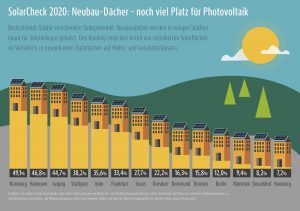 Good news for the PV industry: The solar cap will be abolished and solar expansion will be further promoted. The photovoltaic potential in Germany is enormous - especially when it comes to using roof space on new buildings. The new LichtBlick SolarCheck now shows in detail how well the 14 largest German cities are currently exploiting this potential. Enormous differences are revealed: While Nuremberg (49.1%) and Hanover (46.8%) exploit almost half of their potential, Munich and Düsseldorf do not even reach the 10 percent hurdle. The absolute taillight: the Hanseatic city of Hamburg with only 7.2 percent - one more reason for the solar obligation for new buildings planned by the mayor's office.
Good news for the PV industry: The solar cap will be abolished and solar expansion will be further promoted. The photovoltaic potential in Germany is enormous - especially when it comes to using roof space on new buildings. The new LichtBlick SolarCheck now shows in detail how well the 14 largest German cities are currently exploiting this potential. Enormous differences are revealed: While Nuremberg (49.1%) and Hanover (46.8%) exploit almost half of their potential, Munich and Düsseldorf do not even reach the 10 percent hurdle. The absolute taillight: the Hanseatic city of Hamburg with only 7.2 percent - one more reason for the solar obligation for new buildings planned by the mayor's office.
To calculate the solar potential of the individual cities, the newly built roof areas were put in relation to the newly installed photovoltaic systems in the respective cities in 2018 (most recent figures). The result: the PV potential on roofs is barely exploited in most metropolitan regions in Germany. Yet every new roof without a solar installation is a wasted opportunity for climate protection and a consumer-oriented power supply. The vast majority of people in Germany want solar power from their roofs*.1
In view of the sobering results of the SolarCheck, Ralph Kampwirth, Head of Corporate Communications at LichtBlick, said: "We must finally bring the energy turnaround to the big cities - and the best way to do that is with solar power from the roof. Discussions about distance regulations for wind power or the use of agricultural land for PV plants show that the responsibility should not only lie with the rural population."
 Converted to German households (average consumption 3,000 kWh), the possibilities of the individual cities become apparent: If Munich had fully exploited the potential of the new building roof areas, you could have supplied more than 10,000 households with solar power with the new solar areas built in 2018 alone, Hamburg around 11,500 households, in Berlin it would be 16,200 households." Especially in the megacities, only a small fraction of this is developed, as the SolarCheck shows.
Converted to German households (average consumption 3,000 kWh), the possibilities of the individual cities become apparent: If Munich had fully exploited the potential of the new building roof areas, you could have supplied more than 10,000 households with solar power with the new solar areas built in 2018 alone, Hamburg around 11,500 households, in Berlin it would be 16,200 households." Especially in the megacities, only a small fraction of this is developed, as the SolarCheck shows.
About the research method: The market research company Statista determined the number of newly constructed residential and commercial buildings in 2018 for the 14 German cities with more than 500,000 inhabitants on the basis of data from the State Offices for Statistics and calculated the respective roof areas using scientifically based conversion factors.
Background information on the SolarCheck can be found here:
www.lichtblick.de/.../2020_Hintergrund_Solarcheck2020.pdf (2.83 MB)
*1 representative survey by YouGov in January 2020, see: lichtblick.de/press
Keywords: DE-News, Renewable, Climate protection, Communities, New books and studies, News Blog Bavaria, News Blog Lower Saxony, PV, PlusEnergy house/settlement, Transition Town

